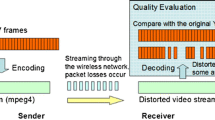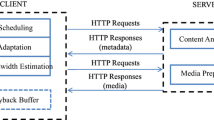Abstract
Multimedia applications including video data require the smoothing of video playout to prevent potential discontinuity. In this paper, we propose a dynamic video playout smoothing method, called the Video Smoother, which dynamically adopts various playout rates in an attempt to compensate for high delay variance of networks. Specifically, if the number of frames in the buffer exceeds a given threshold (TH), the Smoother employs a maximum playout rate. Otherwise, the Smoother uses proportionally reduced rates in an effort to eliminate playout pauses resulting from the emptiness of the playout buffer. To determine THs under various loads, we present an analytic model assuming the Interrupted Poisson Process (IPP) arrival. Based on the analytic results, we establish a paradigm of determining THs and playout rates for achieving different playout qualities under various loads of networks. Finally, to demonstrate the viability of the Video Smoother, we have implemented a prototyping system including a multimedia teleconferencing application and the Video Smoother performing as part of the transport layer. The prototyping results show that the Video Smoother achieves smooth playout incurring only unnoticeable delays.
Similar content being viewed by others
References
L. Aguilar, J.J. Garcia-Luna-Aceves, D. Moran, E.J. Craighill, and R. Brungardt, “Architecture for a multimedia teleconferencing system,” Proc. ACM SIGCOMM'86 Symposium, Aug. 1986, pp. 126–136.
G. Barberis, “Buffer sizing of a packet-voice receiver,” IEEE Transactions on Communications, Vol. COM-29, No. 2, pp. 152–156, Feb. 1981.
J.C. Bolot, “End-to-end packet delay and loss behavior in the internet,” Proc. ACM SIGCOMM, Sept. 1993, pp. 289–298.
D. Clark et al., “An analysis of TCP processing overhead,” IEEE Communication Magazine, Vol. 27, No. 6, pp. 23–29, 1989.
S. Dixit and P. Skelly, “MPEG-2 over ATM for video dial tone networks: Issues and strategies,” IEEE Network, Vol. 9, No. 5, pp. 30–40, Sept. 1995.
D. Gall, “MPEG: A video compression standard for multimedia applications,” Communications of the ACM, Vol. 34, pp. 305–313, April 1991.
O. Hashida and S. Shimogawa, “Switched batch bernoulli process (SBBP) and the discrete-time SBBP/G/1 queue with application to statistical multiplexer,” IEEE Journal on Selected Areas in Communications, Vol. 9, No. 3, pp. 394–401, 1991.
ISO/IEC 13818-2, MPEG-2—Information Technology—Generic Coding of Moving Pictures and Associated Audio, Part 2: Video, Annex C.
V. Jacobson, “Congestion avoidance and control,” Proc. 1988 ACM SIGCOMM, Aug. 1988, pp. 314–329.
H. Kanakia, P. Mishra, and A. Reibman, “An adaptive congestion control scheme for real time packet video transport,” IEEE/ACM Transactions on Networking, Vol. 3, No. 6, pp. 671–682, Dec. 1995.
J. Lin and J. Chen, “The design and implementation of TCP/IP—WinKing,” Document A3k11221-2, Institute for Information Industry (III), 1994.
T.D.C. Little and A. Ghafoor, “Multimedia synchronization protocols for broadband integrated services,” IEEE Journal on Selected Areas in Communications, Vol. 9, No. 9, pp. 1368–1382, Dec. 1991.
W.A. Montgomery, “Techniques for packet voice synchronization,” IEEE Journal on Selected Areas in Communications, Vol. SAC-1, No. 6, pp. 1022–1028, Dec. 1983.
W.E. Naylor and L. Kleinrock, “Stream traffic communication in packet switched networks: Destination beffuring considerations,” IEEE Tansactions on Communications, Vol. COM-30, No. 12, pp. 2527–2534, Dec. 1982.
C. Nicolaou, “An architecture for real-time multimedia communication systems,” IEEE Journal on Selected Areas in Communications, Vol. 8, No. 3, pp. 391–400, April 1990.
P. Parcha and M.El Earki, “MPEG coding for variable bit rate vedio transmission,” IEEE Communications Magazine, Vol. 32, No. 5, pp. 54–66, May 1994.
S. Ramanathan and P.V. Rangan, “Feedback techniques for intra-media continuity and inter-media synchronization in distributed multimedia systems,” The Computer Jounal, Vol. 36, No. 1, pp. 19–31, 1993.
R. Ramjee, J. Kurose, and D. Towsley, “Adaptive playout mechanisms for packetized audio applications in wide-area networks,” IEEE INFOCOM, 1994.
P. Rangan, S. Kumar, and S. Rajan, “Continuity and synchronization in MPEG,” IEEE Journal on Selected Areas in Communications, Vol. 14, No. 1, pp. 52–60, 1996.
S.M. Ross, Stochastic Process, 1983.
H. Schulzrinne, “Voice communication across the internet: A network voice terminal,” Technical Report, Dept. of Computer Science, U. Massachusetts, Amherst, MA, July 1992.
M. Yuang, J. Liu, and C. Shay, “BATS: A high-performance transport system for broadband applications,” Proc. Local Computer Network, 1994.
Author information
Authors and Affiliations
Rights and permissions
About this article
Cite this article
Yuang, M.C., Liang, S.T. & Chen, Y.G. Dynamic Video Playout Smoothing Method for Multimedia Applications. Multimedia Tools and Applications 6, 47–60 (1998). https://doi.org/10.1023/A:1009638628952
Issue Date:
DOI: https://doi.org/10.1023/A:1009638628952




